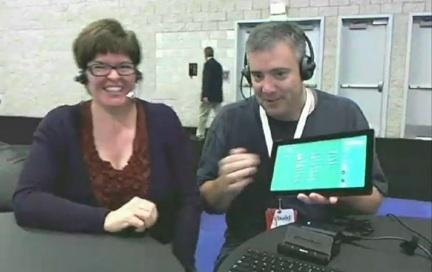Microsoft to take 30% cut of Metro apps under Windows 8
At its BUILD conference with developers, Microsoft has made it clear that while existing Windows 7 desktop apps will continue to move forward in Windows 8 with few changes, the new Metro layer of "touch first" apps that will be targeted at consumers in new PCs and in particular new ARM-based tablets, will be sold through Microsoft's Windows 8 app store with the same fees Apple charges in both its iOS and Mac App Stores.
Windows 8 = Windows 7 + Metro
Recapping Microsoft's announcements, Windows bloggers Mary Jo Foley and Paul Thurrott explained that Microsoft said it will allow its enterprise customers to use Windows 8 essentially as a minor update to the existing Windows 7 by turning off the Metro layer via an IT policy across their users.
For consumer PCs, Windows 8 will ship as essentially Windows 7 overlaid with a new layer of Metro animated graphics capable of running new Metro apps. On standard x86 PCs, this will allow users to run both existing Windows apps as well as downloading new Metro apps from Microsoft's new Windows 8 app market.
On ARM tablets running Windows 8, only the new Metro apps will run, as the president of Microsoft's Windows unit, Stephen Sinofsky, pointedly clarified earlier this week. While PC makers can continue to sell x86 tablets, these devices, ranging from Tablet PC to UMPCs to Slate PC to convertible notebooks with tablet features, have never sold well in the past due to their performance and efficiency compromises and their significant cost premium over modern ARM tablets.
Ported classic apps not likely on Metro tablets
While it's technically possible that Microsoft could allow existing Windows 7 apps to be recompiled to run on ARM processors, Microsoft has carefully avoided promising anything along those lines.
Thurrott noted that "months ago they [Microsoft] did an unfortunately confusing demo where they showed an old version of Office running on ARM, which is never going to happen. And I think the reason they did that is because they wanted to say, 'look, this isn't [Windows] Compact, Embedded or some other weird thing that looks like Windows, it's Windows.' […] That's actually not going to happen in real life. I don't know why they did that demo."
In a statement to blogger Joanna Stern, Mike Anguilo, Microsoft’s vice president of Windows planning said "there is a significant amount of marketing that we are capable of doing that can get through — we can afford to tell a story and tell it long enough and clearly enough. We will make sure it is absolutely clear where your legacy apps will run.â€
Stern added that "he followed that up with a kicker: 'porting things and whether we open native desktop development are either decisions that are either not made or not announced yet.'â€
Microsoft now appears to be willfully skirting the question, preferring to leave the decision of whether to support the potential for porting existing Windows apps to ARM tablets in a nebulous, unknown state. However, it is known that today's x86 apps will simply not run as well on ARM chips, because those chips currently lack the same horsepower and work differently, making the real world migration from the desktop Intel architecture to the mobile ARM architecture far more complex than a simple recompile.
Microsoft has previously supported the ability to deploy Windows XP apps on both Intel x86 and Intel's Itanium hardware, but porting software titles from one processor architecture to a very different one involves lots of optimization work tied to the design of that architecture, particularly when porting in the direction of a slower, simpler architecture optimized for efficient operation rather than raw speed.
Additionally, the potential possibility for developers to port their Windows apps to ARM doesn't mean they would, as the dearth of Itanium-compatible Windows apps illustrates. Windows 8 tablet sales would need to justify the porting effort. Apple would be unlikely to be in any rush to port iTunes to Metro, for example, making it more complicated for Windows 8 tablet users to seamlessly use iOS devices with their tablet.
Microsoft needs a Metro app store
Another factor involved with porting classic Windows apps to ARM is that Microsoft does not appear ready to impose the same App Store-like policies (and fees) on classic Windows apps that it plans to require for Metro apps.
Microsoft would be hard pressed to push the entire existing Windows app ecosystem into an app store bottle within the next year, but if it allowed "side loading" of ported, classic apps on new Windows 8 tablets, it would erase the momentum behind the first step of that effort: pushing developers to submit their apps to its new Windows 8 store for at least Metro apps.
Apple similarly didn't allow developers to port apps to the iPhone or iPad using native Mac Cocoa APIs (or Flash, or Java, or BSD APIs), leaving the iOS App Store as the only option for distributing native apps to iOS users, apart from the open HTML5 web platform. The success of the iOS App Store was then brought to the Mac, where it remains an optional, not compulsory, way to deliver Mac software.
Microsoft has attempted to copy Apple's iOS App Store before, first with its Marketplace for Windows Mobile, an effort from 2009 that it abandoned within months of requiring developers to modify their apps to fit certain specifications and pay to list them in the store. It then resurrected the store as the Windows Phone 7 Marketplace, this time requiring developers to rewrite their software entirely in Silverlight using the Metro UI.
For the Windows 8 store, Microsoft is asking developers to again rewrite from scratch using a revamped Metro UI and a new web-based development environment. Allowing developers to skirt the store to sell their existing Windows apps to Windows 8 tablet users would defeat the entire premise of delivering the new Metro environment.
Using Metro to push iTunes and other competitors off the PC
Speaking to analysts, Microsoft said it would support the idea of allowing competitors to add their own Metro-style apps to the Windows 8 store, providing examples such as an Amazon Kindle ebook reader or Apple's iTunes.
If Microsoft refuses to allow existing Windows apps to run on ARM tablets, that would force Apple to convert iTunes to a Metro app and begin paying it a 30 percent cut unless iTunes remained free, if Apple decided it made sense to distribute iTunes on Windows 8 tablets in the first place. Microsoft has not yet spelled out any plans to charge a 30 percent fee on in-app purchases, but such a policy would suddenly become possible on Windows once Microsoft erected its own Apple-like software store.
That strongly suggests Microsoft hopes to use Metro to win back the market for content from iTunes, which rapidly became the most popular media player and store among Windows PC users. By pushing out Metro first as a tablet UI and slowly converting the Windows PC desktop into an app store-only software model, Microsoft could begin to impose far more control over all software sold within the Windows PC environment, something it originally sought to do under Palladium Trusted Computing, an effort that sparked a tremendous backlash given Microsoft's already dominant position in PCs.
If Microsoft established its own app store for Windows, it could then favor the use of its own services and software, ranging from Windows Media Player to Bing web search, two products that have failed to gain traction in the market, losing to Apple's iTunes and Google's search. Unlike Apple, Microsoft's app store would gain software control over every PC maker globally, leveraging the company's existing monopoly position of Windows and raising new anticompetitive issues.
 Daniel Eran Dilger
Daniel Eran Dilger











 Malcolm Owen
Malcolm Owen
 Charles Martin
Charles Martin
 Mike Wuerthele
Mike Wuerthele


 Chip Loder
Chip Loder

 William Gallagher
William Gallagher






97 Comments
So they've decided to even copy Apple's business strategies?
Qualcomm based tablet running Windows 8 showing a Flash enabled webpage inside IE 10 Desktop version:
http://www.engadget.com/2011/09/16/a...#disqus_thread
Maybe it is Apple copying Xbox Live service.
Will be cool to run my old Windows apps on a tablet! Such innovation.
If I remember correctly, Apple gets 30% of app revenues too, right? Makes sense. If W8 tablets gain significant marketshare, that would obviously being enticing to developers as their cut of the revenue is the same percentage for whichever platform. But we'll see how the tablets do first.
Will be cool to run my old Windows apps on a tablet! Such innovation.
You're making a joke, right? Zero existing Windows applications will work on these tablets. You know that.
THE ARTICLE EXPLICITLY SAYS THIS IS THE CASE.